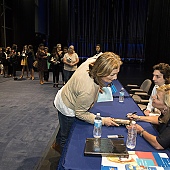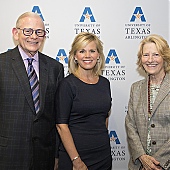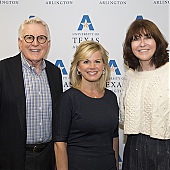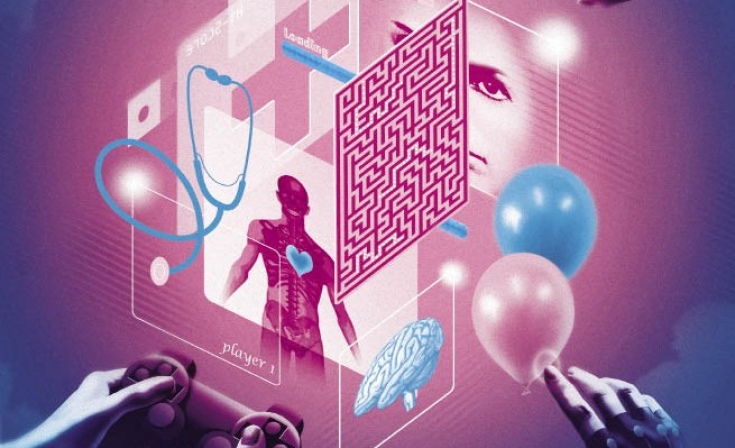
Gaming Gets Serious
Video games transport players into make-believe worlds where they vanquish mortal enemies and win the world’s biggest sporting competitions. But for UT Arlington researchers, they represent a novel way to train nurses, improve communication among caregivers, battle teenage substance abuse, and treat children with cerebral palsy.
· Spring 2012 · Comment ·
Emily is 8 months old and has cystic fibrosis, a chronic genetic disease that affects the lungs and digestive system. Admitted to the hospital for a persistent cough, she hasn’t been gaining weight, cries frequently, and breathes rapidly.
What should the nurse do?
The scenario is part of iNursingRN, a virtual game that teaches undergraduate nursing students how to identify, diagnose, and treat pediatric respiratory conditions. Students can see the child lying in a crib, use a stethoscope to listen to her breathing, and check the heart rate.
“People get better with practice. That is true with golf, changing diapers, or nursing,” says Associate Professor Judy LeFlore, who created iNursingRN. “Games provide a safe venue for practice, with no repercussions to making a mistake. Virtual patients will not die.”
Video games have long captivated the masses with fantasy worlds of intergalactic war, organized crime, and sports glory. But a new crop of games such as iNursingRN aims to achieve far more than entertainment. Using the same eye-catching graphics, the games train students and professionals in fields ranging from medicine and defense to public policy and emergency management.
Known as “serious gaming,” the idea has caught on at UT Arlington, where researchers are developing high-level games to better prepare nurses, prevent violence in dating among teenagers, and assess children with cerebral palsy.
“Teachers have used games for a long, long time as an educational tool,” says Ben Sawyer, co-founder of the national Serious Games Initiative, which promotes the creation of games for learning. “What we are seeing now is more sophisticated forms of games that have arisen from the popularity of video games.
“We’re in the beginning stages, but the potential is tremendous.”
PLAYING NURSE
From her office on the sixth floor of Pickard Hall, Dr. LeFlore, a 20-year nursing veteran, enters the neonatal intensive care unit.
The first patient is Peyton, a 26-week premature baby just brought in from labor and delivery. LeFlore inspects Peyton’s fontanel (the soft spot on a newborn’s head), her nose, mouth, vital signs, and X-rays. She listens to lung and heart sounds.
BABY STEPS
Through the Nursing AP computer-based simulation she created, Associate Professor Judy LeFlore helps students determine the best care for preemies.
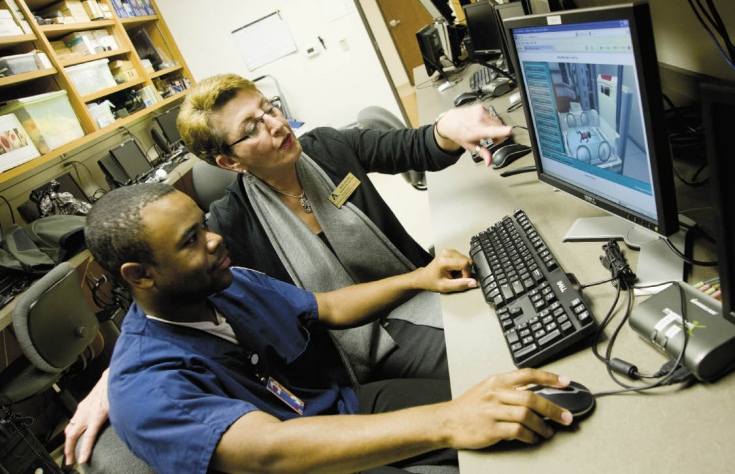
When she’s ready, LeFlore can write and submit orders for Peyton, including how much fluid she should be given, what antibiotics she needs, and when she might be discharged.
This is Nursing AP, a computer-based simulation LeFlore created for graduate students. The work was funded by a $750,000 grant from the Health Resources and Services Administration. Like iNursingRN—which was backed by a $250,000 grant from the UT System’s Transforming Undergraduate Education program—the game offers nursing students an alternative, hands-on way to learn.
Such programs could strengthen nursing schools, which face faculty shortages but are under increasing pressure to produce more graduates. State studies predict that the demand for registered nurses will far outpace the supply over the next decade.
“I’m not trying to reinvent the textbook or replace traditional lectures. We need much more research in these areas,” LeFlore says. “We are trying to provide one more way to teach material and reach students who feel comfortable with screen-based technology.”
Results have been encouraging. In a 2010 study, LeFlore split a class of seniors into two groups. One group listened to a traditional three-hour lecture on pediatric and neonatal respiratory diseases. The other group played iNursingRN.
Ten days later the students were tested on the material at UT Arlington’s Smart Hospital, a 13,000-square-foot facility with full-body interactive patient simulators. On a multiple-choice test, students who played the game scored a full letter grade higher than students who heard the lecture. And the game players performed clinical care using manikin-based simulators more accurately and quickly, sometimes minutes faster.
“In the hospital environment, we know every minute is crucial,” LeFlore says. “The students who played the game were better prepared and more comfortable performing critical functions.”
“Games provide a safe venue for practice, with no repercussions to making a mistake. Virtual patients will not die.”
Outside the University, LeFlore’s project earned the top spot in a competition sponsored by the Society for Simulation in Healthcare. In January 2011 she presented the research, which won first place in Emerging and Innovative Technologies and Methods.
VIDEO HEALTH CARE
Communication lapses can lead to serious, even deadly medical mistakes. The Joint Commission, a national organization that accredits and certifies health care organizations, has identified communication among caregivers as a key national patient safety goal.
Yet relatively little attention is paid to teaching and maintaining communication skills, says Beth Mancini, associate dean of the College of Nursing.
So Dr. Mancini, working with the Baylor Health Care System and UT Dallas, is creating a video game-like simulation to improve communication between doctors and nurses. The U.S. Agency for Healthcare Research and Quality is funding the work with just under $1 million.
“We know that when communication between nurses and doctors is optimized, there are better outcomes for patients,” says Mancini, who spent nearly 30 years as a practicing nurse. “How can you deliver information in a way that ensures you get your message across? That’s our question.”
Initially, the game will focus on surgeons and nurses caring for post-operative patients. Currently in the design stage, researchers are hosting focus groups to discuss possible scenarios. A nurse could call a doctor at 2 a.m. to discuss a patient’s medication, for example.
SMART CHOICES
Gary Grossman, a social worker in the Arlington school district, watches Valentino Yazzie and other Venture School students play a video game developed by School of Social Work professors. Called “Choices and Consequences,” it helps teenagers make wise decisions about substance abuse and dating.
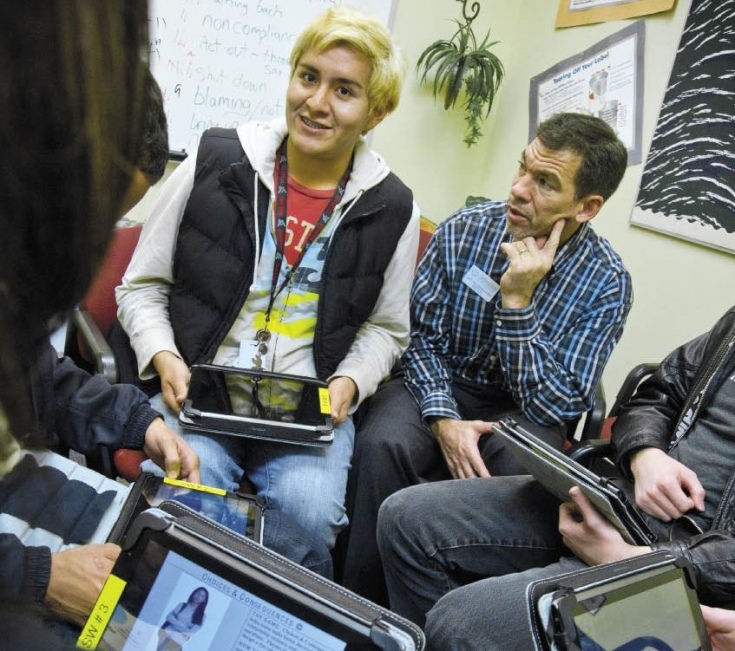
Over the next year, the team will refine the game and begin recruiting 120 nurses and 25 physicians at Baylor to do pilot testing.
“Not everyone will find serious gaming the best way to learn. But for some, this could be an incredibly powerful and engaging tool for changing behavior,” Mancini says. “They can learn communications strategies at home when convenient for them, which gives us a lot of flexibility. We can bring the learning to them.”
Games can benefit patients, too.
Led by Fillia Makedon, chair of the Department of Computer Science and Engineering, a team of engineering researchers is developing a video game to improve the physical and mental assessments of children with cerebral palsy.
Typically caused by brain injury or abnormal development before birth, the disorder can affect movement, muscle control and coordination, posture, and balance. An estimated 800,000 people in the United States have cerebral palsy, according to United Cerebral Palsy, which provides support services to those affected.
UT Arlington researchers have received more than $800,000 from the National Science Foundation to develop the CPLAY system, which would allow children ages 5 to 8 to undergo therapy from home.
Using a screen, the children could be asked to pop a balloon, match colors, or drag a finger through a maze. A data glove could allow an occupational therapist to determine the movement of the hand and fingers as the child plays.
“This would have tremendous benefits to children and their parents,” Dr. Makedon says. “Parents are usually desperate for help. They can’t take their children to an occupational therapist every day, and they can’t spend 24 hours a day working with them. A game system would offer families one more avenue for help.”
Angie Boisselle, a consultant on the project and an occupational therapist at Cook Children’s Health Care System, reasons that handheld devices and screen-based games appeal to children, and this would allow therapists to easily track a child’s progress.
“These games would benefit both families and the therapists,” Boisselle says. “As therapists, we think of ourselves as facilitators. We are focused on helping parents perform the exercises with their children. Teaching them how to use a game would give them the tools they need.”
The work does not end there. Makedon and fellow researchers also plan to create game-based systems for adults with Alzheimer’s disease and severe depression, and for stroke survivors.
TARGETING TEENS
Perhaps no group plays video games more than teenagers. A team of UT Arlington professors set out to capitalize on the comfort many teens have with technology.
In a partnership with Venture School, an alternative high school in Arlington, School of Social Work professors Javier Boyas, Beverly Black, and Richard Schoech produced a game to prepare teenagers to navigate tricky social situations involving substance abuse and dating violence.
The goal of the game, called “Choices and Consequences,” is to have a fun, safe weekend. Beginning after school Friday and ending Sunday, players must decide what to do in a series of situations ranging from whether to drink alcohol with friends to how to meet someone in person after meeting online.
UT Arlington computer science and engineering researchers helped build the pilot game, and students at Venture School are providing feedback. When completed, the game will target 13-year-olds.
“We are just starting to tap into the potential of gaming,” Dr. Boyas says. “Through ‘Choices and Consequences,’ we hope to determine if we can use gaming to prevent and lessen rates of substance use and dating violence among young people.”
Venture School social worker Gary Grossman says the game frequently leads to spirited class discussions about drinking, violence, and other issues teens face. “Teenagers have an immediate comfort level and familiarity with technology, which opens them up to learning. Games provide us with a rich forum.”
The Amon G. Carter Foundation and the Innovative Community and Academic Partnership provided funding for the project, which Boyas hopes to expand to other schools.
“Technology is very much a part of our everyday lives,” he says. “If we can use that to tailor our educational lessons, we have the opportunity to reach people who might not respond to a traditional lecture.”










